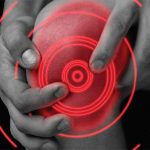
A physical therapist uses a goniometer to test a patient’s range of motion.
aceshot1 / shutterstock.com
Pain is the main reason patients with osteoarthritis (OA) seek medical help because of the substantial burden it imposes and its impact on quality of life. Pain can actually change the way the central nervous system works. This central sensitization results in more pain with less provocation. And according to results from an observational study of hospitalized patients with hand OA in Norway, sensitization is independently related to the severity of pain experienced by people with hand osteoarthritis (OA), no matter their psychological profile or radiographic disease severity.
The research involved the largest group—282 patients—to date to be studied for the link between pressure pain thresholds and the degree of pain in the disease. Researchers used temporal summation (i.e., a measure of an increasing pain response due to repetitive painful stimuli) to assess central sensitization, in which heightened neural signaling in the spinal cord and brain brings about a greater pain sensitivity to stimuli.
“Our article is the first to describe quantitative sensory testing of temporal summation in persons with hand OA, and the first to describe pressure pain thresholds at both local and remote sites in a large hand OA study population,” says Pernille Steen Pettersen, MD, a PhD student at Diakonhjemmet Hospital, Oslo, Norway. “We demonstrated that having these clinically assessed semi-objective signs of peripheral and/or central sensitization was related to experiencing clinically relevant, greater hand pain severity.”
Treatment of hand OA is frequently focused on symptoms, with limited effect, and the link between the total amount of osteoarthritis pathology and pain levels tends to be weak. “This reflects the fact that pain experience is a complex subjective phenomenon influenced by a number of biologic, psychological and social factors,” the researchers wrote.
The Details
This study was an attempt to examine sensitization and pain severity in hand OA patients in a large sample.
Researchers tested pressure pain thresholds at diseased sites to assess patients for peripheral or central sensitization, or both, and pressure pain thresholds at distant, non-painful sites to assess for central sensitization. Patients were divided into tertiles by gender, mindful of pain threshold differences between genders. To measure temporal summation, probes of increasing weights were used. The first to elicit a pain response was used for the test, and pain ratings were recorded over the course of repeated probe applications.
On the numerical rating scale of hand pain in the last 24 hours, pain severity was reported by 32% of patients to be above the acceptable level. On the Australian/Canadian Osteoarthritis Hand Index (AUSCAN), pain was above the acceptable level for 52% of patients.
Researchers found that those with the lowest pressure pain thresholds reported higher numerical rating scale scores—a one-point difference on a 0–10 range test for painful finger joints and a 1.2-point difference in non-painful finger joints—than those with the highest thresholds.
After adjustments, an independent association between pain threshold and pain severity was found only on numerical rating scale scores—with a ß coefficient (i.e., a measure of sensitivity) of 0.9 [95% CI 0.2, 1.6] for painful finger joints and 1.1 [95% CI 0.5, 1.8) for non-painful joints. No independent association was found for pain severity measured on the AUSCAN.
The researchers also found that pressure pain thresholds at distant body sites, such as the wrist and trapezius muscle, had significant independent associations with pain severity on the numerical rating scale for measurements taken at the wrist and trapezius muscle.
Researchers found that temporal summation, demonstrating central sensitization, was present in 42% of patients. Those patients reported numerical rating scale scores an average of one point higher than those without temporal summation, researchers said. After an adjusted analysis, an association between temporal summation and pain severity was found only for the numerical rating scale, not the AUSCAN.

